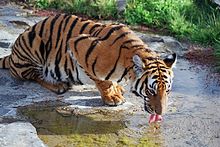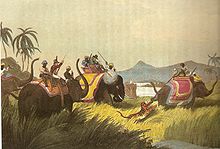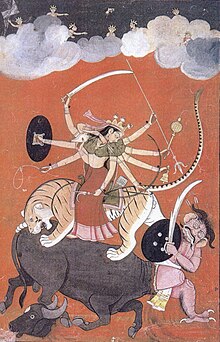Tiger: Difference between revisions
Report bugs here. |
Extended confirmed users, Pending changes reviewers 53,969 edits →In captivity: extended with ref |
||
| Line 359: | Line 359: | ||
Part of the reason for America's large tiger population relates to legislation. Only nineteen states have banned private ownership of tigers, fifteen require only a license, and sixteen states have no regulations at all.<ref>{{cite web|url=http://www.bornfreeusa.org/b4a2_exotic_animals_summary.php |title=Summary of State Laws Relating to Private Possession of Exotic Animals |publisher=Bornfreeusa.org |accessdate=2010-12-12}}</ref> |
Part of the reason for America's large tiger population relates to legislation. Only nineteen states have banned private ownership of tigers, fifteen require only a license, and sixteen states have no regulations at all.<ref>{{cite web|url=http://www.bornfreeusa.org/b4a2_exotic_animals_summary.php |title=Summary of State Laws Relating to Private Possession of Exotic Animals |publisher=Bornfreeusa.org |accessdate=2010-12-12}}</ref> |
||
The success of breeding programmes at American zoos and circuses led to an overabundance of cubs in the 1980s and 1990s, which drove down prices for the animals. The [[Society for the Prevention of Cruelty to Animals of Texas |
The success of breeding programmes at American zoos and circuses led to an overabundance of cubs in the 1980s and 1990s, which drove down prices for the animals. The [[Society for the Prevention of Cruelty to Animals of Texas]] estimate there are now 500 lions, tigers and other big cats in private ownership just in the [[Houston, Texas]].{{Verify source|date=June 2011}} |
||
[[Genetic ancestry]] of 105 captive tigers from 14 countries and regions was assessed by using [[Bayesian analysis]] and diagnostic [[genetic marker]]s defined by a prior analysis of 134 voucher tigers of significant genetic distinctiveness. Of the 105 captive tigers, 49 specimen were assigned to one of five subspecies; 52 specimen had admixed subspecies origins.<ref>Luo,S., Johnson,W. E., Martenson, J., Antunes, A., Martelli, P., Uphyrkina, O., Traylor-Holzer, K., Smith, J. L.D., O’Brien, S. J. (2008) [http://cimar.org/Arquivo/Press_Releases/CurBio_Antunes_paper2008.pdf ''Subspecies Genetic Assignments of Worldwide Captive Tigers Increase Conservation Value of Captive Populations'']. Current Biology 18: 592–596.</ref> |
|||
The Tiger [[Species Survival Plan]] devised by the [[Association of Zoos and Aquariums]] has condemned the breeding of [[white tiger]]s on the allegation that they are of mixed ancestry, hybridized with other subspecies and are of unknown lineage. The [[gene]]s responsible for white colour are represented by 0.001% of the population. The disproportionate growth in numbers of white tigers points to the relentless [[inbreeding]] resorted to among [[homozygous]] [[recessive]] individuals for selectively multiplying the white animals. This progressively increasing process will eventually lead to [[inbreeding depression]] and loss of [[genetic variability]].<ref>Xavier, N. (2010) [http://www.ias.ac.in/currsci/10oct2010/894.pdf ''A new conservation policy needed for reintroduction of Bengal tiger-white'']. Current Science 99 (7): 894–895.</ref> |
|||
===Cultural depictions=== |
===Cultural depictions=== |
||
Revision as of 16:06, 15 October 2011
| Tiger | |
|---|---|

| |
| A Ranthambhore National Park .
| |
| Scientific classification | |
| Kingdom: | |
| Phylum: | |
| Class: | |
| Order: | |
| Family: | |
| Genus: | |
| Species: | P. tigris
|
| Binomial name | |
| Panthera tigris (Linnaeus, 1758)
| |
| Subspecies | |
|
P. t. tigris | |

| |
| Historical distribution of tigers (pale yellow) and 2006 (green).[2] | |
| Synonyms | |
|
Tigris striatus Severtzov, 1858 | |
The tiger (Panthera tigris), a member of the
Tigers have a lifespan of 10–15 years in the wild, but can live longer than 20 years in captivity.[8] They are highly adaptable and range from the Siberian taiga to open grasslands and tropical mangrove swamps.
They are territorial and generally
Historically, tigers have existed from Mesopotamia and the Caucasus throughout most of South and East Asia. Today, the range of the species is radically reduced. All surviving species are under formal protection, yet poaching, habitat destruction, and inbreeding depression continue to threaten the tigers.
Tigers are among the most recognisable and popular of the world's
Naming and etymology
The word "tiger" is taken from the Greek word "tigris", which is possibly derived from a Persian source meaning "arrow", a reference to the animal's speed and also the origin for the name of the Tigris river.[10][11] In American English, "tigress" was first recorded in 1611. It was one of the many species originally described by Linnaeus in his 18th century work, Systema Naturae: he called it Felis tigris.[3][12] The generic component of its scientific designation, Panthera tigris, is often presumed to derive from Greek pan- ("all") and theron ("beast"), but this may be a folk etymology. Although it came into English through the classical languages, panthera is probably of Indian origin, meaning "the yellowish animal", or "whitish-yellow".[13]
Tigers rarely form groups (see below), but the collective nouns applied when they do are either "ambush" or "streak".[14][15]

Range and habitat
In the past, tigers were found throughout Asia, from the Caucasus and the Caspian Sea to Siberia and Indonesia and even in Borneo[16] and Palawan in the Philippines.[17] Today the range of the tiger is only 7% of what it used to be.[18] Furthermore, within the past decade alone, the estimated area known to be occupied by tigers has declined by 41%.[18]
During the 19th century, the tiger completely vanished from western Asia and became restricted to isolated pockets in the remaining parts of their range. Today, their range is fragmented, and certain parts degraded, and extends from
Tiger
Among the big cats, only the tiger and jaguar are strong swimmers; tigers are often found bathing in ponds, lakes, and rivers. During the extreme heat of the day, they often cool off in pools. Tigers are excellent swimmers, and are able to carry prey through the water.
Physical characteristics, taxonomy and evolution
The oldest remains of a tiger-like cat, called
Tigers first reached India and northern Asia in the late Pleistocene, reaching eastern
Physical characteristics

Tigers typically have rusty-reddish to brown-rusty coats, a whitish
The pattern of stripes is unique to each animal, these unique markings can be used by researchers to identify individuals (both in the wild and captivity), much in the same way that fingerprints are used to identify humans. It seems likely that the function of stripes is camouflage, serving to help tigers conceal themselves amongst the dappled shadows and long grass of their environment as they stalk their prey. The stripe pattern is also found on the skin of the tiger. If a tiger were to be shaved, its distinctive camouflage pattern would be preserved.
Like other big cats, tigers have a white spot on the backs of their ears. These spots, called

Tigers have the additional distinction of being the heaviest cats found in the wild.
The tiger are the most variable in size of all big cats, even more so than the
Tigresses are smaller than the males in each subspecies, although the size difference between male and female tigers tends to be more pronounced in the larger subspecies of tiger, with males weighing up to 1.7 times more than the females.[29] In addition, male tigers have wider forepaw pads than females. Biologists use this difference to determine gender based on tiger tracks.[30] The skull of the tiger is very similar to that of the lion, though the frontal region is usually not as depressed or flattened, with a slightly longer postorbital region. The skull of a lion has broader nasal openings. However, due to the amount of skull variation in the two species, usually, only the structure of the lower jaw can be used as a reliable indicator of species.[31]
Tigers have round pupils and yellow irises (except for the blue eyes of white tigers). Due to a retinal adaptation that reflects light back to the retina, the night vision of tigers is six times better than that of humans.[32]
Subspecies
There are nine recent subspecies of tiger, three of which are extinct. Their historical range (severely diminished today) ran through Bangladesh, Siberia, Iran, Afghanistan, India, China, and southeast Asia, including some Indonesian islands. The surviving subspecies, in descending order of wild population, are:
- The Forest Rights Act by the Indian government in 2006 has worsened the situation as evidence has shown that human habitats and tigers cannot co-exist and has pushed the Indian tiger on the brink of extinction.[38] However, another census by the government in 2011 using better counting methods showed a rise of 20%, taking the numbers to 1,706.[39]

- The Burma, Thailand, and Vietnam. These tigers are smaller and darker than Bengal tigers: Males weigh from 150–190 kg (330–420 lb) while females are smaller at 110–140 kg (240–310 lb). Their preferred habitat is forests in mountainous or hilly regions. Estimates of the Indochinese tiger population vary between 1,200 to 1,800, with only several hundred left in the wild. All existing populations are at extreme risk from poaching, prey depletion as a result of poaching of primary prey species such as deer and wild pigs, habitat fragmentation and inbreeding. In Vietnam, almost three-quarters of the tigers killed provide stock for Chinese pharmacies.

- The coat of arms and in logos of Malaysian institutions, such as Maybank.


- The critically endangered.[41] It is the smallest of all living tiger subspecies, with adult males weighing between 100–140 kg (220–310 lb) and females 75–110 kg (165–243 lb).[42] Their small size is an adaptation to the thick, dense forests of the island of Sumatra where they reside, as well as the smaller-sized prey. The wild population is estimated at between 400 and 500, seen chiefly in the island's national parks. Recent genetic testing has revealed the presence of unique genetic markers, indicating that it may develop into a separate species,[specify] if it does not go extinct.[43] This has led to suggestions that Sumatran tigers should have greater priority for conservation than any other subspecies. While habitat destructionis the main threat to existing tiger population (logging continues even in the supposedly protected national parks), 66 tigers were recorded as being shot and killed between 1998 and 2000, or nearly 20% of the total population.
- The Ussuri region of Primorsky Krai and Khabarovsk Krai in far eastern Siberia, where it is now protected.[44] The largest subspecies of tiger, it has a head and body length of 160–180 cm (63–71 in) for females and 190–230+ cm (75–91 in) for males, plus a tail of about 60–110 cm long (about 270–330 cm in total length) and an average weight of around 227 kilograms (500 lb) for males,[34] the Amur tiger is also noted for its thick coat, distinguished by a paler golden hue and fewer stripes. The heaviest wild Siberian tiger on record weighed in at 384 kilograms (847 lb),[45] but according to Mazak these giants are not confirmed via reliable references.[24] Even so, a six-month old Siberian tiger can be as big as a fully grown leopard. The last two censuses (1996 and 2005) found 450–500 Amur tigers within their single, and more or less continuous, range making it one of the largest undivided tiger populations in the world. Genetic research in 2009 demonstrated that the Siberian tiger, and the western "Caspian tiger" (once thought to have been a separate subspecies that became extinct in the wild in the late 1950s[46][47]) are actually the same subspecies, since the separation of the two populations may have occurred as recently as the past century due to human intervention.[48]

- The South China tiger (Panthera tigris amoyensis), also known as the Amoy or Xiamen tiger, is the most critically endangered subspecies of tiger and is listed as one of the 10 most endangered animals in the world.[49][clarification needed] One of the smaller tiger subspecies, the length of the South China tiger ranges from 2.2–2.6 m (87–102 in) for both males and females. Males weigh between 127 and 177 kg (280 and 390 lb) while females weigh between 100 and 118 kg (220 and 260 lb). From 1983 to 2007, no South China tigers were sighted.[50] In 2007 a farmer spotted a tiger and handed in photographs to the authorities as proof.[50][51] The photographs in question, however, were later exposed as fake, copied from a Chinese calendar and digitally altered, and the “sighting” turned into a massive scandal.[52][53][54]
In 1977, the Chinese government passed a law banning the killing of wild tigers, but this may have been too late to save the subspecies, since it is possibly already extinct in the wild. There are currently 59 known captive South China tigers, all within China, but these are known to be descended from only six animals. Thus, the genetic diversity required to maintain the subspecies may no longer exist. Currently, there are breeding efforts to reintroduce these tigers to the wild.
Extinct subspecies
- The Bali tiger (Panthera tigris balica) was limited to the island of Bali. They were the smallest of all tiger subspecies, with a weight of 90–100 kg in males and 65–80 kg in females.[24] These tigers were hunted to extinction—the last Balinese tiger is thought to have been killed at Sumbar Kima, West Bali on 27 September 1937; this was an adult female. No Balinese tiger was ever held in captivity. The tiger still plays an important role in Balinese Hinduism.
- The Javan tiger (Panthera tigris sondaica) was limited to the Indonesian island of Java. It now seems likely that this subspecies became extinct in the 1980s, as a result of hunting and habitat destruction, but the extinction of this subspecies was extremely probable from the 1950s onwards (when it is thought that fewer than 25 tigers remained in the wild). The last confirmed specimen was sighted in 1979, but there were a few reported sightings during the 1990s.[55][56] With a weight of 100–141 kg for males and 75–115 kg for females, the Javan tiger was one of the smaller subspecies, approximately the same size as the Sumatran tiger.[citation needed]
- The Caspian tiger (formerly Panthera tigris virgata), also known as the Persian tiger or Turanian tiger was the westernmost population of Siberian tiger, found in Iran, Iraq, Afghanistan, Turkey, Mongolia, Kazakhstan, the Caucasus, Tajikistan, Turkmenistan, and Uzbekistan until it apparently became extinct in the late 1950s, though there have been several alleged more recent sightings of the tiger.[47] Though originally thought to have been a distinct subspecies, genetic research in 2009 suggest that the animal was largely identical to the Siberian tiger.[48]
Hybrids
Hybridisation among the big cats, including the tiger, was first conceptualised in the 19th century, when zoos were particularly interested in the pursuit of finding oddities to display for financial gain..
The liger is a cross between a male lion and a tigress.[59] Because the lion sire passes on a growth-promoting gene, but the corresponding growth-inhibiting gene from the female tiger is absent, ligers grow far larger than either parent. They share physical and behavioural qualities of both parent species (spots and stripes on a sandy background). Male ligers are sterile, but female ligers are often fertile. Males have about a 50% chance of having a mane, but, even if they do, their manes will be only around half the size of that of a pure lion. Ligers are typically between 10 to 12 feet in length, and can be between 800 and 1,000 pounds or more.[59]
The less common tigon is a cross between the lioness and the male tiger.[60]
Colour variations
White tigers


There is a well-known mutation that produces the
Golden tabby tigers
In addition, another recessive gene may create a very unusual "golden tabby" colour variation, sometimes known as "strawberry." Golden tabby tigers have light gold fur, pale legs and faint orange stripes. Their fur tends to be much thicker than normal.
Other colour variations
There are also unconfirmed reports of a "blue" or slate-coloured tiger, the
Biology and behaviour
Territorial behaviour
Tigers are essentially solitary and territorial animals. The size of a tiger's home range mainly depends on prey abundance, and, in the case of male tigers, on access to females. A tigress may have a territory of 20 square kilometres, while the territories of males are much larger, covering 60–100 km2. The range of a male tends to overlap those of several females.
The relationships between individuals can be quite complex, and it appears that there is no set "rule" that tigers follow with regards to territorial rights and infringing territories. For instance, although for the most part tigers avoid each other, both male and female tigers have been documented sharing kills. George Schaller observed a male tiger share a kill with two females and four cubs. Females are often reluctant to let males near their cubs, but Schaller saw that these females made no effort to protect or keep their cubs from the male, suggesting that the male might have been the father of the cubs. In contrast to male lions, male tigers will allow the females and cubs to feed on the kill first. Furthermore, tigers seem to behave relatively amicably when sharing kills, in contrast to lions, which tend to squabble and fight. Unrelated tigers have also been observed feeding on prey together. The following quotation is from Stephen Mills' book Tiger, as he describes an event witnessed by Valmik Thapar and Fateh Singh Rathore in Ranthambhore:[68]
A dominant tigress they called Padmini killed a 250 kg (550-lb) male nilgai – a very large antelope. They found her at the kill just after dawn with her three 14-month-old cubs and they watched uninterrupted for the next ten hours. During this period the family was joined by two adult females and one adult male – all offspring from Padmini's previous litters and by two unrelated tigers, one female the other unidentified. By three o'clock there were no fewer than nine tigers round the kill.
When young female tigers first establish a territory, they tend to do so fairly close to their mother's area. The overlap between the female and her mother's territory tends to wane with increasing time. Males, however, wander further than their female counterparts, and set out at a younger age to mark out their own area. A young male will acquire territory either by seeking out a range devoid of other male tigers, or by living as a transient in another male's territory until he is old and strong enough to challenge the resident male. The highest mortality rate (30–35% per year) amongst adult tigers occurs for young male tigers who have just left their natal area, seeking out territories of their own.[69]

Male tigers are generally more intolerant of other males within their territory than females are of other females. For the most part, however, territorial disputes are usually solved by displays of intimidation, rather than outright aggression. Several such incidents have been observed, in which the subordinate tiger yielded defeat by rolling onto its back, showing its belly in a submissive posture.[70] Once dominance has been established, a male may actually tolerate a subordinate within his range, as long as they do not live in too close quarters.[69] The most violent disputes tend to occur between two males when a female is in oestrus, and may result in the death of one of the males, although this is a rare occurrence.[69][71]
To identify his territory, the male marks trees by
Tigers have been studied in the wild using a variety of techniques. The populations of tigers were estimated in the past using plaster casts of their pugmarks. This method was found faulty[72] and attempts were made to use camera trapping instead. Newer techniques based on DNA from their scat are also being evaluated. Radio collaring has also been a popular approach to tracking them for study in the wild.
Hunting and diet
In the wild, tigers mostly feed on larger and medium sized
Adult
Old tigers, or those wounded and rendered incapable of catching their natural prey, have turned into man-eaters; this pattern has recurred frequently across India. An exceptional case is that of the Sundarbans, where healthy tigers prey upon fishermen and villagers in search of forest produce, humans thereby forming a minor part of the tiger's diet.[74] Tigers will occasionally eat vegetation for dietary fiber, the fruit of the Slow Match Tree being favoured.[73]

Tigers are thought to be nocturnal predators, hunting at night.[75] However, in areas where humans are absent, they have been observed via remote controlled, hidden cameras hunting during the daylight hours.[76] They generally hunt alone and ambush their prey as most other cats do, overpowering them from any angle, using their body size and strength to knock large prey off balance. Even with their great masses, tigers can reach speeds of about 49–65 kilometres per hour (35–40 miles per hour), although they can only do so in short bursts, since they have relatively little stamina; consequently, tigers must be relatively close to their prey before they break their cover. Tigers have great leaping ability; horizontal leaps of up to 10 metres have been reported, although leaps of around half this amount are more typical. However, only one in twenty hunts ends in a successful kill.[75]
When hunting large prey, tigers prefer to bite the throat and use their forelimbs to hold onto the prey, bringing it to the ground. The tiger remains latched onto the neck until its prey dies of
During the 1980s, a tiger named "Genghis" in
Reproduction

Mating can occur all year round, but is generally more common between November and April.[82] A female is only receptive for a few days and mating is frequent during that time period. A pair will copulate frequently and noisily, like other cats. The gestation period is 16 weeks. The litter size usually consists of around 3–4 cubs of about 1 kilogram (2.2 lb) each, which are born blind and helpless. The females rear them alone, sheltering them in dens such as thickets and rocky crevices. The father of the cubs generally takes no part in rearing them. Unrelated wandering male tigers may even kill cubs to make the female receptive, since the tigress may give birth to another litter within 5 months if the cubs of the previous litter are lost.[82] The mortality rate of tiger cubs is fairly high – approximately half do not survive to be more than two years old.[82]
There is generally a dominant cub in each litter, which tends to be male but may be of either sex.[81] This cub generally dominates its siblings during play and tends to be more active, leaving its mother earlier than usual. At 8 weeks, the cubs are ready to follow their mother out of the den, although they do not travel with her as she roams her territory until they are older. The cubs become independent around 18 months of age, but it is not until they are around 2–2½ years old that they leave their mother. Females reach sexual maturity at 3–4 years, whereas males reach sexual maturity at 4–5 years.[82]
Over the course of her life, a female tiger will give birth to an approximately equal number of male and female cubs. Tigers breed well in captivity, and the captive population in the United States may rival the wild population of the world.[83]
Interspecific predatory relationships

Tigers may kill such formidable predators as
Conservation efforts
Poaching for fur and destruction of habitat have greatly reduced tiger populations in the wild. At the start of the 20th century, it is estimated there were over 100,000 tigers in the world but the population has dwindled to between 1,500 and 3,500 in the wild.[93] Some estimates suggest that there are less than 2,500 mature breeding individuals, with no subpopulation containing more than 250 mature breeding individuals.[1]
India
India is home to the world's largest population of tigers in the wild.
A major concerted conservation effort, known as Project Tiger, has been underway since 1973, initially spearheaded by Indira Gandhi. The fundamental accomplishment has been the establishment of over 25 well-monitored tiger reserves in reclaimed land where human development is categorically forbidden. The program has been credited with tripling the number of wild Bengal tigers from roughly 1,200 in 1973 to over 3,500 in the 1990s. However, a tiger census carried out in 2007, whose report was published on February 12, 2008, stated that the wild tiger population in India declined by 60% to approximately 1,411.[98] It is noted in the report that the decrease of tiger population can be attributed directly to poaching.[99]
Following the release of the report, the Indian government pledged $153 million to further fund the
Tigers Forever is a collaboration between the Wildlife Conservation Society and Panthera Corporation to serve as both a science-based action plan and a business model to ensure that tigers live in the wild forever. Initial field sites of Tigers Forever include the world’s largest tiger reserve, the 21,756 km² Hukaung Valley in Myanmar, the Western Ghats in India, Thailand’s Huai Khai Khaeng-Thung Yai protected areas, and other sites in Laos PDR, Cambodia, the Russian Far East and China covering approximately 260,000 km2 of critical tiger habitat.[19][104]
Russia

The Siberian tiger was on the brink of extinction with only about 40 animals in the wild in the 1940s. Under the
Tibet
The trade in tiger skins is illegal in the
Population estimate
The global tiger population is estimated at anywhere between 3,062 and 5,066. The
| Country | Minimum | Maximum | Reliability |
|---|---|---|---|
| 200 | 419 | Fair | |
| 67 | 81 | Fair | |
| 11 | 50 | Fair | |
| 37 | 50 | Fair | |
| 1,165 | 1,657 | Good | |
| 441 | 679 | Fair | |
| 30 | 30 | Fair | |
| 300 | 493 | Fair | |
| 100 | 150 | Fair | |
| 100 | 194 | Good | |
| unknown | unkown | na | |
| 331 | 393 | Good | |
| 250 | 720 | Fair | |
| 50 | 150 | Poor | |
| Total | 3,062 | 5,066 | na |
Rewilding
Origin
Although the term "rewilding" was used in
One noted attempt at
Save China's Tigers
The organisation Save China's Tigers, working with the Wildlife Research Centre of the State Forestry Administration of China and the Chinese Tigers South Africa Trust, secured an agreement on the reintroduction of Chinese tigers into the wild. The agreement, which was signed in
South Africa was chosen as a springboard thanks to its leadership in wildlife management, readily available land, and abundant
Success story of rewilding
Save China's Tigers' South China Tiger rewilding and reintroduction project has been deemed a success. Recently, renown
The tigers involved, were born in captive conditions, in concrete cages and their parents are all captive animals who are unable to sustain in the wild. They were sent to South Africa as part of the Save China's Tigers project to rewilding and ensure that they regain the necessary skills needed for a predator to survive in the wild.
Results of the workshop confirmed the important role of the South China Tiger Rewilding Project in tiger conservation. ““Having seen the tigers hunting in an open environment at Laohu Valley Reserve, I believe that these rewilded tigers have the skill to hunt in any environment.” Dr. David Smith remarked. Furthermore, Save China's Tigers recovered natural habitat both in China and in South Africa during their attempt to reintroduce South China Tigers back into the wild.[126]
The goal is of preparing tigers born in captivity for introduction to wild habitat in China where tigers once lived seems to be very possible in the near future based on the success of the rewilding and reintroduction program.[127]
Relation with humans
Tiger as prey

The tiger has been one of the
Man-eating tigers
Although humans are not regular prey for tigers, they have killed more people than any other cat, particularly in areas where population growth, logging, and farming have put pressure on tiger habitats. Most man-eating tigers are old and missing teeth, acquiring a taste for humans because of their inability to capture preferred prey.[129] Almost all tigers that are identified as man-eaters are quickly captured, shot, or poisoned. Unlike man-eating leopards, even established man-eating tigers will seldom enter human settlements, usually remaining at village outskirts.[130] Nevertheless, attacks in human villages do occur.[131] Man-eaters have been a particular problem in India and Bangladesh, especially in Kumaon, Garhwal and the Sundarbans mangrove swamps of Bengal, where some healthy tigers have been known to hunt humans. Because of rapid habitat loss due to climate change, tiger attacks have increased in the Sundarbans.[132]
A female tiger Tatiana escaped from her enclosure in the San Francisco Zoo, killing one person and seriously injuring two more before being shot and killed by the police. The enclosure had walls that were lower than they were legally required to be, allowing the tiger to climb the wall and escape.
Traditional Asian medicine
Many people in China have a belief that various tiger parts have medicinal properties, including as pain killers and aphrodisiacs.[133] There is no scientific evidence to support these beliefs. The use of tiger parts in pharmaceutical drugs in China is already banned, and the government has made some offenses in connection with tiger poaching punishable by death. Furthermore, all trade in tiger parts is illegal under the Convention on International Trade in Endangered Species of Wild Fauna and Flora and a domestic trade ban has been in place in China since 1993. Still, there are a number of tiger farms in the country specialising in breeding the cats for profit. It is estimated that between 5,000 and 10,000 captive-bred, semi-tame animals live in these farms today.[134][135][136]
In captivity
In recent years, captive breeding of tigers in China has accelerated to the point where the captive population of several tiger subspecies exceeds 4,000 animals. Three thousand specimens are reportedly held by 10–20 “significant” facilities, with the remainder scattered among some 200 facilities. This makes China home to the second largest captive tiger population in the world, after the
Part of the reason for America's large tiger population relates to legislation. Only nineteen states have banned private ownership of tigers, fifteen require only a license, and sixteen states have no regulations at all.[139] The success of breeding programmes at American zoos and circuses led to an overabundance of cubs in the 1980s and 1990s, which drove down prices for the animals. The
The Tiger
Cultural depictions
The tiger replaces the lion as King of the Beasts in cultures of eastern Asia,[142] representing royalty, fearlessness and wrath.[143] Its forehead has a marking which resembles the Chinese character 王, which means "king"; consequently, many cartoon depictions of tigers in China and Korea are drawn with 王 on their forehead.[citation needed]
Of great importance in Chinese myth and culture, the
In Buddhism, it is also one of the Three Senseless Creatures, symbolising anger, with the monkey representing greed and the deer lovesickness.[143]

The
The widely worshiped Hindu goddess Durga, an aspect of Devi-Parvati, is a ten-armed warrior who rides the tigress (or lioness) Damon into battle. In southern India the god Ayyappan was associated with a tiger.[144]
The weretiger replaces the werewolf in shapeshifting folklore in Asia;[145] in India they were evil sorcerers while in Indonesia and Malaysia they were somewhat more benign.[146]
The tiger continues to be a subject in literature; both
The Tiger is the national animal of Bangladesh, Nepal, India[147] (Bengal Tiger), Malaysia (Malayan Tiger), North Korea and South Korea (Siberian Tiger).
World's favourite animal
In a poll conducted by Animal Planet, the tiger was voted the world's favourite animal, narrowly beating the dog. More than 50,000 viewers from 73 countries voted in the poll. Tigers received 21% of the vote, dogs 20%, dolphins 13%, horses 10%, lions 9%, snakes 8%, followed by elephants, chimpanzees, orangutans and whales.[148][149][150][151]
Animal behaviourist Candy d'Sa, who worked with Animal Planet on the list, said: "We can relate to the tiger, as it is fierce and commanding on the outside, but noble and discerning on the inside".[148]
Callum Rankine, international species officer at the World Wildlife Federation conservation charity, said the result gave him hope. "If people are voting tigers as their favourite animal, it means they recognise their importance, and hopefully the need to ensure their survival," he said.[148]
See also
- 21st Century Tiger, information about tigers and conservation projects
- Endangered subspecies of tiger
- List of solitary animals
- Panthera Corporation, big cat conservation organisation
- Siegfried & Roy, two famous tamers of tigers
- Tiger in Chinese culture
- Tiger penis
- Tiger Temple, a Buddhist temple in Thailand famous for its tame tigers
- Tiger versus lion
Cited references
- ^ a b Template:IUCN2008
- ^ "Wild Tiger Conservation". Save The Tiger Fund. Retrieved 2009-03-07.
- ^ Linnaeus, Carolus (1758). Systema naturae per regna tria naturae:secundum classes, ordines, genera, species, cum characteribus, differentiis, synonymis, locis. Vol. 1 (10th ed.). Holmiae (Laurentii Salvii). p. 41. Retrieved 2008-09-08.
- ^ "Encyclopaedia Britannica Online – Tiger (Panthera tigris)". Retrieved 25 September 2007.
- ^ Cat Specialist Group.
- ^ "BBC Wildfacts – Tiger".
- ^ "Animal Face-Off: Lion vs. Tiger : Video : Animal Planet". Animal.discovery.com. 2008-04-29. Retrieved 2010-06-10.
- ^ "Tiger Facts and Sound – Panthera tigris – Defenders of Wildlife – Defenders of Wildlife". Defenders.org. 2010-02-14. Retrieved 2010-06-10.
- Govt. of IndiaOfficial website.
- ISBN 0-19-910207-4.
- ^ "'Tiger' at the Online Etymology Dictionary". Etymonline.com. Retrieved 2009-03-07.
- . Holmiae. (Laurentii Salvii). p. 824.
- ^ "Panther". Online Etymology Dictionary. Douglas Harper. Retrieved 2007-07-05.
- ^ "Animal group names". Zoological Society of San Diego.
- ^ "Common Questions: What Do You Call a Group of...?". U.S. Geological Survey Northern Prairie Wildlife Research Center.
- ^ Piper, P.J. (2007). "Confirmation of the presence of the tiger Panthera tigris (L.) in Late Pleistocene and Holocene Borneo". Malayan Nature Journal. 59 (3): 259–267.
{{cite journal}}: Unknown parameter|coauthors=ignored (|author=suggested) (help) - doi:10.1016/j.palaeo.2008.04.003.)
{{cite journal}}: Unknown parameter|coauthors=ignored (|author=suggested) (help - ^ doi:10.1641/B570608.
- ^ .
- ^ Van den Hoek Ostende. 1999. Javan Tiger – Ruthlessly hunted down. 300 Pearls – Museum highlights of natural diversity. Downloaded on August 11, 2006.
- .
- ^ a b c "WWF – Tigers – Ecology".[dead link] Cite error: The named reference "WWF" was defined multiple times with different content (see the help page).
- ISBN 0-89658-329-5 [title =Big Cats: Kingdom of Might title =Big Cats: Kingdom of Might].)
{{cite book}}: Check|url=value (help); Missing or empty|title=(help); Missing pipe in:|url=(help - ^ a b c d e f Template:De icon Vratislav Mazak: Der Tiger. Nachdruck der 3. Auflage von 1983. Westarp Wissenschaften Hohenwarsleben, 2004 ISBN 3-89432-759-6 Cite error: The named reference "der-tiger" was defined multiple times with different content (see the help page).
- ^ Tigers. Physical Characteristics and Special Adaptations. seaworld.org
- ^ "Tiger". The Animal Files. 1937-09-27. Retrieved 2011-07-25.
- ^ Bengal Tiger: Factsheet. ypte.org.uk (2011)
- ^ Tiger. BBC. (2011)
- ^ Matthiessen, Peter. 2000. Tigers in the Snow, p. 47. The Harvill Press, London.
- ^ )
- ^ ISBN 9004088768. Cite error: The named reference "USSR" was defined multiple times with different content (see the help page).
- ^ Zoo animals. (2010)
- ^ John L Gittleman Exploring Mammals, Marshall Cavendish, 2007 ISBN 0761477195
- ^ a b c Sunquist, Mel and Fiona Sunquist. 2002. Wild Cats of the World. University Of Chicago Press, Chicago
- ^ "Task force says tigers under siege". Indianjungles.com. 2005-08-05. Retrieved 2009-03-07.
- ^ Wade, Matt (February 15, 2008). "Threat to a national symbol as India's wild tigers vanish". The Age (Melbourne). p. 9.
{{cite news}}: Invalid|ref=harv(help) - ^ "No tigers found in Sariska: CBI". DeccanHerald.com. Archived from the original on 2007-02-10. Retrieved 2007-07-20. (Archive).
- ^ "Tigers driven to edge of extinction", Independent, accessed 31 Oct 2007
- ^ a b "BBC News – India wild tiger census shows population rise". Bbc.co.uk. 2011-03-28. Retrieved 2011-07-25.
- ^ "Laboratory of Genomic Diversity LGD".
- ^ Template:IUCN2011.1
- ^ *Nowak, Ronald M. (1999) Walker's Mammals of the World. Johns Hopkins University Press. ISBN 0-8018-5789-9
- .
- JSTOR 1383657.)
{{cite journal}}: CS1 maint: multiple names: authors list (link - ^ Graham Batemann: Die Tiere unserer Welt Raubtiere, Bertelsmann Verlag, 1986.
- ^ "The Caspian Tiger – Panthera tigris virgata". Retrieved 12 October 2007.
- ^ a b "The Caspian Tiger at www.lairweb.org.nz". Retrieved 12 October 2007.
- ^ a b "Mitochondrial Phylogeography Illuminates the Origin of the Extinct Caspian Tiger and Its Relationship to the Amur Tiger". Plosone.org. Retrieved 2010-06-10.
- ^ www.china.org.cn Retrieved on 6 October 2007
- ^ a b "绝迹24年华南虎重现陕西 村民冒险拍下照片". News.xinhuanet.com. Retrieved 2009-03-07.
- ^ "Rare China tiger seen in the wild". BBC News. 2007-10-12. Retrieved 2009-03-07.
- ^ "South China tiger photos are 'fake'". China Daily. 2007-11-17. Retrieved 2009-03-07.
- ^ "South China tiger photos are fake: provincial authorities". China Daily. 2008-06-29. Retrieved 2009-03-07.
- ^ Page, Jeremy (2008-06-30). "Farmer's photo of rare South China tiger is exposed as fake". London: The Times. Retrieved 2009-03-07.
- ^ "Bambang M. 2002. In search of 'extinct' Javan tiger. The Jakarta Post (October 30)". Thejakartapost.com. Archived from the original on January 20, 2008. Retrieved 2009-03-07.
- ^ "Harimau jawa belum punah! (Indonesian Javan Tiger website)".
- ^ "History of big cat hybridisation". Retrieved 28 September 2007.
- ISBN 0-8008-8324-1.
- ^ )
- ^ "tigon – Encyclopædia Britannica Article". Retrieved 12 September 2007.
- ^ a b "White tigers". Retrieved 25 September 2007.
- ^ a b "The white tiger today and the unusual white lion". Lairweb.org.nz. Retrieved 2010-06-10.
- ^ "White Tigers". Bigcatrescue.org. Retrieved 2010-06-10.
- ^ "White Tiger Facts". Retrieved 26 September 2007.
- ^ "White Tigers". Bigcathaven.org. Retrieved 2010-06-10. [dead link]
- ^ "Snow Tigers". Bigcatrescue.org. Retrieved 2010-06-10.
- ^ "Golden tabby Bengal tigers". Lairweb.org.nz. Retrieved 2009-03-07.
- ^ Mills, Stephen. (2004). Tiger. p. 89. BBC Books, London
- ^ a b c Mills, Stephen. p. 86
- ^ Thapar, Valmik. (1989). Tiger:Portrait of a Predator. p. 88. Smithmark Pub, New York
- ^ Thapar, Valmik. p. 88
- ^ Karanth, K.U., Nichols, J.D., Seidensticker, J., Dinerstein, E., Smith, J.L.D., McDougal, C., Johnsingh, A.J.T., Chundawat, R.S. (2003) Science deficiency in conservation practice: the monitoring of tiger populations in India. Animal Conservation (61): 141–146 Full text
- ^ a b c d Perry, Richard (1965). The World of the Tiger. p. 260. ASIN: B0007DU2IU.
- ^ "Man-eaters. The tiger and lion, attacks on humans". Lairweb.org.nz. Retrieved 2009-03-07.
- ^ a b ADW:Panthera tigris: Information, animaldiversity.ummz.umich.edu
- ^ Tiger: Spy In The Jungle. John Downer Productions. BBC (2008)
- ^ Schaller. G The Deer and the Tiger: A Study of Wildlife in India 1984, University Of Chicago Press[dead link]
- ^ Sankhala 1997, p. 17
- ^ Sankhala 1997, p. 23
- ^ ISBN 1552979490.
- ^ a b Thapar, Valmik. (1992). The Tiger's Destiny. Kyle Cathie Ltd: Publishers, London
- ^ a b c d Nowak, Ronald M. (1999). Walker's Mammals of the World. Baltimore: Johns Hopkins University Press. ISBN 0-8018-5789-9
- ^ "Zoogoer – Tiger, Panthera tigris". Retrieved 5 October 2007.
- ^ "Tiger –". Bangalinet.com. Retrieved 2009-03-07.
- ^ "Tiger – Oakland Zoo". Oaklandzoo.org. Retrieved 2009-03-07.
- ^ Sunquist, Fiona & Mel Sunquist. 2002. Tiger Moon, The University of Chicago Press, Chicago, ISBN 0226779971
- ISBN 1-1451-1108-4.
- ^ "Sympatric Tiger and Leopard: How two big cats coexist in the same area".[dead link] Ecology.info
- doi:10.1111/j.1469-7998.2000.tb01076.x.)
{{cite journal}}: Invalid|ref=harv(help); Unknown parameter|coauthors=ignored (|author=suggested) (help - IUCN. Archived from the originalon February 9, 2006. Retrieved 2007-08-17.
- ^ "Amur Tiger". Save The Tiger Fund. Archived from the original on July 12, 2007. Retrieved 2007-08-17.
- ISBN 0897472306.
- ^ "Tiger". Big Cat Rescue. Retrieved 2009-03-07.
- ^ Tigress joins lone tiger in Sariska, Times of India, 4 July 2008.
- ISBN 9780852297605. Retrieved 2010-06-10.
- ^ Independent Online. "'World tiger population shrinking fast'". Iol.co.za. Retrieved 2010-06-10.
- ^ Dinerstein, E., Loucks, C., Heydlauff, A., Wikramanayake, E., Bryja, G., Forrest, J., Ginsberg, J., Klenzendorf, S., Leimgruber, P., O'Brien, T., Sanderson, E., Seidensticker, J., and Songer, M. Setting Priorities for the Conservation and Recovery of Wild Tigers: 2005–2015. A User's Guide. 1–50. 2006. Washington, D.C. – New York, WWF, WCS, Smithsonian, and NFWF-STF.[dead link]
- ^ Only 3500 tigers left worldwide – WWF[dead link]
- ^ "Front Page : Over half of tigers lost in 5 years: census". The Hindu. 2008-02-13. Retrieved 2010-06-10.
- ^ Page, Jeremy (2008-07-05). "Tigers flown by helicopter to Sariska reserve to lift numbers in western India". The Times. London. Retrieved 2010-05-25.
- ^ "India Reports Sharp Decline in Wild Tigers". News.nationalgeographic.com. Retrieved 2010-06-10.
- ^ "It's the tale of a tiger, two tigresses in wilds of Sariska". Economictimes.indiatimes.com. 2009-03-02. Retrieved 2010-06-10.
- ^ "Tigers galore in Ranthambhore National Park". Hindu.com. 2009-03-11. Retrieved 2010-06-10.
- ^ Rabinowitz, A. 2009. Stop the bleeding: implementing a strategic Tiger Conservation Protocol. Cat News 51:30–31.[dead link]
- ^ J.M., D.G. Miquelle, E.M. Smirnov, L.L. Kerley, H.B. Quigley, and M.G. Hornocker. 2010. Spatial structure of Amur (Siberian) tigers (Panthera tigris altaica) on Sikhote-Alin Biosphere Zapovednik, Russia. Journal of Mammalogy, 91(3), 737–748.[dead link]
- ^ Timothy E. Fulbright, David G. Hewitt Wildlife Science: Linking Ecological Theory and Management Applications, CRC Press, 2007, ISBN 0-8493-7487-1
- ^ "Dalai Lama campaigns for wildlife". BBC News. April 6, 2005. Retrieved 2007-07-20.
- ^ Justin Huggler (February 18, 2006). "Fur flies over tiger plight". New Zealand Herald. Tibet.com. Archived from the original on July 14, 2007. Retrieved 2007-07-20.
- ^ "Animal Skin Clothes Burned In Tibet After Dalai Lamas Call". The Office of His Holiness the Dalai Lama. 2006-02-17. Retrieved 2010-12-04.
- ^ WWF – Tiger – Overview. Worldwildlife.org (2011-08-10). Retrieved on 2011-09-27.
- ^ http://www.iucnredlist.org/documents/attach/15955.pdf
- ^ Jennifer Foote, "Trying to Take Back the Planet," Newsweek, 5 February 1990, pp. 24–25
- ^ "Indian tiger isn't 100% "swadeshi (Made in India)"; by Pallava Bagla; Indian Express Newspaper; November 19, 1998". Indianexpress.com. 1998-11-19. Retrieved 2009-03-07.
- ^ "Tainted Royalty, Wildlife: Royal Bengal Tiger, a controversy arises over the purity of the Indian tiger after DNA samples show Siberian tiger genes. By Subhadra Menon. India Today, November 17, 1997". India-today.com. 1997-11-17. Retrieved 2009-03-07.
- ^ "The Tale of Tara, 4: Tara's Heritage from Tiger Territory website". Lairweb.org.nz. 1999-11-22. Retrieved 2009-03-07.
- ^ "Genetic pollution in wild Bengal tigers, Tiger Territory website". Lairweb.org.nz. Retrieved 2009-03-07.
- ^ "Interview with Billy Arjan Singh: Dudhwa's Tiger man, October 2000, Sanctuary Asia Magazine". Sanctuaryasia.com. 1917-08-15. Retrieved 2009-03-07.
- ^ "Mitochondrial DNA sequence divergence among big cats and their hybrids by Pattabhiraman Shankaranarayanan* and Lalji Singh*, *Centre for Cellular and Molecular Biology, Uppal Road, Hyderabad 500 007, India, Centre for DNA Fingerprinting and Diagnostics, CCMB Campus, Uppal Road, Hyderabad 500 007, India". Iisc.ernet.in. Retrieved 2009-03-07.
- ^ "Central Zoo Authority of India (CZA), Government of India". CZA. Retrieved 2009-03-07.
- ^ ""Indians Look At Their Big Cats' Genes", Science, Random Samples, Volume 278, Number 5339, Issue of 31 October 1997, 278: 807 (DOI: 10.1126/science.278.5339.807b) (in Random Samples),The American Association for the Advancement of Science". Sciencemag.org. Retrieved 2009-03-07.
- ^ "BOOKS By & About Billy Arjan Singh". Fatheroflions.org. Retrieved 2009-03-07.
- ^ "Book – Tara: The Cocktail Tigress/Ram Lakhan Singh. Edited by Rahul Karmakar. Allahabad, Print World, 2000, xxxviii, 108 p., ills., $22. ISBN 81-7738-000-1. A book criticizing Billy Arjan Singh's release of hand reared hybrid Tigress Tara in the wild at Dudhwa National Park in India". Vedamsbooks.com. Retrieved 2009-03-07.
- ^ a b "FAQs | Save China's Tigers". English.savechinastigers.org. 2004-07-25. Retrieved 2010-06-10.
- ^ "FAQs | Save China's Tigers". English.savechinastigers.org. 2004-07-25. Retrieved 2009-03-07.
- ^ "The Baby Tiger That's Beating Extinction | Youtube Channel-SkyNews". Youtube.com. 2007-12-04. Retrieved 2010-06-10.
- ^ "Scientists Confirm the Role of Rewilding Captive Populations to Save the South China Tiger". English.savechinastigers.org. Retrieved 2010-12-12.
- ^ "Tiger cubs saved by catwoman". Express.co.uk. 2010-10-05. Retrieved 2010-12-12.
- ^ vide Royal Tiger (nom-de-plume) in The Manpoora Tiger – about a Tiger Hunt in Rajpootanah. (1836) Bengal Sporting Magazine, Vol IV. reproduced in The Treasures of Indian Wildlife
- ^ "Man-eaters. The tiger and lion, attacks on humans". Lairweb.org.nz. Retrieved 2009-03-07.
- ^ "Man-eaters. The tiger and lion, attacks on humans". Lairweb.org.nz. Retrieved 2009-03-07.
- ^ "Increasing tiger attacks trigger panic around Tadoba-Andhari reserve". Indianexpress.com. 2007-10-18. Retrieved 2009-03-07.
- ^ "Climate change linked to Indian tiger attacks". Retrieved 27 October 2008.
- ^ Harding, Andrew (2006-09-23). "Programmes | From Our Own Correspondent | Beijing's penis emporium". BBC News. Retrieved 2009-03-07.
- ^ "Chinese tiger farms must be investigated". WWF. Retrieved 2009-03-07.[dead link]
- ^ "WWF: Breeding tigers for trade soundly rejected at cites". Panda.org. Retrieved 2009-03-07.[dead link]
- ^ Jackson, Patrick (29 January 2010). "Tigers and other farmyard animals". BBC News. Retrieved 29 January 2010.
- ^ Nowell, K., Ling, X. (2007) Taming the tiger trade: China's markets for wild and captive tiger products since the 1993 domestic trade ban. TRAFFIC East Asia, Hong Kong, China.
- ^ Wildlife Watch Group (2011) Less than 3,000 Pet Tigers in America . Wildlife Times 5 (37): 12–13.
- ^ "Summary of State Laws Relating to Private Possession of Exotic Animals". Bornfreeusa.org. Retrieved 2010-12-12.
- ^ Luo,S., Johnson,W. E., Martenson, J., Antunes, A., Martelli, P., Uphyrkina, O., Traylor-Holzer, K., Smith, J. L.D., O’Brien, S. J. (2008) Subspecies Genetic Assignments of Worldwide Captive Tigers Increase Conservation Value of Captive Populations. Current Biology 18: 592–596.
- ^ Xavier, N. (2010) A new conservation policy needed for reintroduction of Bengal tiger-white. Current Science 99 (7): 894–895.
- ^ "Tiger Culture | Save China's Tigers". English.savechinastigers.org. Retrieved 2009-03-07.
- ^ ISBN 1-85538-118-4. Cite error: The named reference "Cooper92" was defined multiple times with different content (see the help page).
- ^ Balambal, V (1997). "19. Religion – Identity – Human Values – Indian Context". Bioethics in India: Proceedings of the International Bioethics Workshop in Madras: Biomanagement of Biogeoresources, 16–19 January 1997. Eubios Ethics Institute. Retrieved 2007-10-08.
- ^
ISBN 0517180936.
- ^ Encyclopædia Britannica Eleventh Edition. 1910–1911.
- Govt. of Indiawebsite,
- ^ a b c Independent Online. "Tiger tops dog as world's favourite animal". Int.iol.co.za. Retrieved 2009-03-07.
- ^ Pers – The Tiger is the World's Favorite Animal[dead link]
- ^ "CBBC Newsround | Animals | Tiger 'is our favourite animal'". BBC News. 2004-12-06. Retrieved 2009-03-07.
- ^ "Endangered tiger earns its stripes as the world's most popular beast | Independent, The (London) | Find Articles at BNET.com". Findarticles.com. 2004-12-06. Archived from the original on January 20, 2008. Retrieved 2009-03-07.
References
- Brakefield, T. (1993). Big cats kingdom of might, Voyageur press.
- Dr. Tony Hare. (2001) Animal Habitats P. 172 ISBN 0-8160-4594-1
- Kothari, Ashok S. & Chhapgar, Boman F. (eds). 2005. The Treasures of Indian Wildlife. Bombay Natural History Society and Oxford University Press, Mumbai.
- Mazák, V. (1981). Panthera tigris. (PDF). Mammalian Species, 152: 1–8. American Society of Mammalogists.
- Nowak, Ronald M. (1999) Walker's Mammals of the World. Johns Hopkins University Press. ISBN 0-8018-5789-9
- Sankhala, K. (1997). "Der indische Tiger und sein Reich" (Document). Bechtermuenz Verlag.
{{cite document}}: Invalid|ref=harv(help); Unknown parameter|isbn=ignored (help) Abridged German translation of Return of the Tiger, Lustre Press, 1993. - Seidensticker, John. (1999) Riding the Tiger. Tiger Conservation in Human-dominated Landscapes Cambridge University Press. ISBN 0-521-64835-1
External links
- Truth about Tigers: Website with a lot of answers to the conservation issues faced by tigers
- 21st Century Tiger: information about tigers and conservation projects
- Biodiversity Heritage Library bibliography for Panthera tigris
- Save The Tiger Fund: Program of the National Fish and Wildlife Foundation
- Tiger Canyons Homepage: information about tigers and the Crossbred Tiger Rewilding project
- Tigers in Crisis: Information about Earth's Endangered Tigers
- WWF – Tigers
- Tiger Stamps: Tiger images on postage stamps from many different countries.
- Save China's Tigers: information about tigers and the South China Tiger rewilding project in Africa
- Sundarbans Tiger Project: research and conservation of tigers in the largest remaining mangrove forest in the world
- Explore T.I.G.E.R.S: The Institute of Greatly Endangered and Rare Species
- EIA tiger campaign: 15 years investigating the tiger trade, reports etc.
- EIA in the USA: reports etc.
- Tale of the Cat; Mar. 01, 2010; By Andrew Marshall; TIME Magazine (in partnership with CNN)
- BBC Year of the tiger: A video collection from the BBC highlighting the plight of the Tiger. Produced in celebration of the 2010 Year of the Tiger.
- Watch more tiger (Panthera tigris) video clips from the BBC archive on Wildlife Finder
Template:Link GA Template:Link GA Template:Link FA Template:Link FA Template:Link FA Template:Link FA Template:Link FA Template:Link FA Template:Link FA Template:Link FA Template:Link FA Template:Link GA

